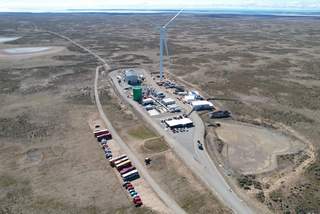
eFuels pilot plant Haru Oni, Punta Arenas, Chile, 2022, Porsche AG © Porsche AG
Full speed ahead toward climate neutrality
The innovative spirit of German industrial companies is not only evident in the Federal Republic itself. Sometimes it also unleashes its power in faraway places, for example in Puntas Arenas in the south of Chile. In this area, it is very windy on around 270 days a year - the ideal location not only for wind turbines, but also for a process that makes use of wind power: power-to-liquid technology for the production of synthetic fuels. At the end of 2022, German car manufacturer Porsche put the plant, named Haru Oni ("the place where the wind blows"), into operation. It is the first of its kind in the world. Porsche has invested more than 100 million euros in the pilot project and the operator High Innovative Fuels Global (HIF).
Porsche relies on an e-mix
Synthetic fuels are one component of the sports car manufacturer's sustainability strategy, in addition to electromobility. "Porsche is focusing on a double E: electromobility and complementary e-fuels," says Barbara Frenkel, Executive Vice President Procurement at Porsche AG. For good reason: There are around 1.3 billion combustion engine cars worldwide today. A large proportion of them will still be on the roads for years to decades to come.
Synthetic fuels are therefore an important building block for reducing pollutant emissions in traffic and achieving the European climate targets. They can be used directly in the combustion engines that already exist today and enable so to say a CO2-neutral locomotion if they are produced using renewable energies. This is the case with Porsche's plant. In addition to individual transportation, synthetic fuels also offer great potential for those fields of application for which green electricity is not available as a primary energy, such as aviation and shipping.
The process: Power-to-Liquid
The central component of Haru Oni is an electrolysis system from Siemens Energy. It uses electricity from wind power to break down water into hydrogen and oxygen. In an intermediate step, it enriches the green hydrogen with carbon dioxide from the ambient air. Further synthesis processes convert the resulting synthesis gas into methanol, the basic material for liquid synthetic fuels. Since the production of e-fuels based on wind power binds about as much carbon dioxide as the combustion engine later emits again when consuming the fuel, the carbon footprint is balanced.
In the first phase of the pilot project, Porsche plans to produce around 130,000 liters of e-fuels in Chile. These will initially be used in racing, in the Porsche Mobile 1 Supercup, and in the Porsche Experience Centers. By the middle of the decade, the volume is expected to grow to 55 million liters per year, with the next step about two years later being 550 million liters of e-fuels per year - depending on the ongoing approval processes.
For production on a larger scale, the immediate onward transport of the e-fuels is also assured, as the plant is strategically located in the immediate vicinity of the Strait of Magellan. From there, ships can transport the new fuel all over the world and connect directly to the existing infrastructure for conventional fuels.



